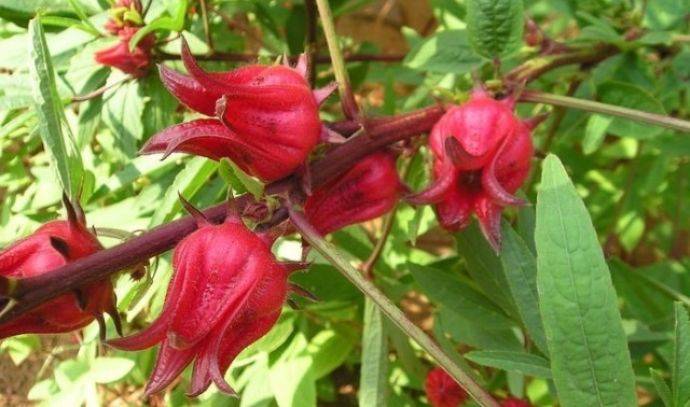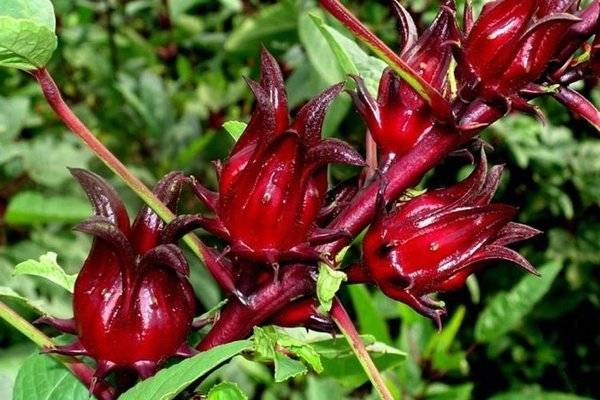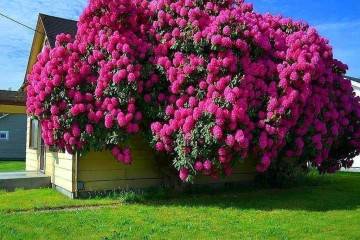Sudanese rose (Rosella, Hibiscus) - what is it
Content:
Sudanese rose is a popular plant popularly called hibiscus. It is from the petals of this flower that a fragrant and tasty drink is made, which many have tried. Such a rose grows in the tropics, but you can also grow it at home. However, before that, you must familiarize yourself with the description of the plant, as well as with the features of caring for it.
Description of characteristics
Hibiscus rose is a shrub plant that can grow up to four meters in height. The main feature of this shrub is its developed root system. It grows rapidly, branches and goes deeper into the soil. Because of this, when transplanting a rose at home, you have to dig a very deep hole.
The surface of the stems of the shrub is greenish with a slight reddish tint. When the plant is more than two years old, a thin gray crust will begin to appear on the stems. The leaves of the Sudanese rose have a rough surface and denticles along the edges. Their upper part is slightly pointed, and the lower one has an oval shape.
In the process of growing, flowers are formed on the plant. They are colored dark red. The diameter of the buds can reach 5-7 centimeters. The flower petals are quite juicy and fleshy, they immediately attract attention. They contain the most useful components that are needed for the development of a rose.
Healing properties
Many fans of oriental medicine know about the benefits of this plant. A delicious and healthy hibiscus tea is made from the Sudanese rose, which will help to cope with diseases of the cardiovascular system. Also, this drink should be drunk by hypotensive patients to increase blood pressure.
In addition to normalizing blood pressure, regular consumption of rose tea contributes to:
- strengthening the vascular walls;
- elimination of cholesterol;
- cleansing the body of parasites;
- elimination of a hangover.
Reproduction
Before growing a Sudanese rose, you need to familiarize yourself with the features of its reproduction. There are two main ways that flower growers use when breeding this flower.
Seeds
The easiest way to grow these flowers is from ordinary seeds. This is the least time-consuming and simple method that does not require special knowledge and skills from a person. In addition, the seed retains its germination capacity for five years. It is necessary to plant seeds in the second half of February. First, they are planted in pots for germinating seedlings. Then the plant is transplanted into open ground or a larger pot.
Cuttings
Experienced growers, who have been growing plants for several years, use young cuttings for growing roses. When using this breeding method, the following recommendations must be observed:
- Pruning cuttings is necessary only in the spring.
- For rooting and further planting, it is better to use the upper cuttings.
- Cut stems should be immediately treated with growth stimulants and soaked.
- The planted cuttings must be grown under plastic for the first 2-3 months.
It is important to follow all of the listed rules in order to get a healthy bush.
Planting a rose
Every person who plans to grow the Sudanese hibiscus rose should familiarize himself with the nuances of planting it.
Soil preparation
The condition of a home rose directly depends on the soil in which it is planted. It is not recommended to plant it in places where fruit trees, shrubs or vegetables were previously grown. In such areas, the rose will not grow well, since the soil is very depleted and most likely infested with pests. For planting, it is better to choose a long-empty place where nothing has been grown before.
The soil on the site selected for planting must be prepared in advance. To begin with, the old topsoil is removed and a fresh one is poured. Then mineral fertilizers are added, mixed with manure.
Seed preparation
Before planting roses in the country, you need to prepare planting material. First, you need to select the most suitable seeds for planting. To do this, they are poured into a glass of salt water. Seeds that have begun to float are discarded, as they will germinate more slowly.
Seeds selected for further planting must first germinate. During the day they are soaked in wet gauze. Then the soaked seeds are planted in small pots with soil. After 4-5 days, it will be possible to replace the first seedlings on the soil surface.
Open ground transplant
When the plants have the first true leaves with rosettes, you can start transplanting roses into open ground. This is done in several sequential stages:
- Digging a hole. Its dimensions must be such that the root system of the transplanted plant fits completely into it.
- Adding dressings. Each hole is pre-fertilized with organic matter and mineral fertilizing mixtures.
- Landing. The sprouted flower is carefully dug out of the pot and planted in the hole.
- Watering. The transplanted rose is watered with water warmed to room temperature and sprinkled with soil on top.
Care
In order for a planted Sudanese rose to grow strong and healthy, it must be properly cared for.
Watering
It is necessary to water the flower regularly so that the soil is not constantly dry. On hot summer days, the plant is watered at least four times a week. In the spring, soil moistening is done less often - 2-3 times within 10 days. During the flowering period, watering should be intensified, as the plant begins to consume more moisture.
Top dressing
In the spring, top dressing is applied to the ground only once - in the second half of April. Nitrogen-containing fertilizers are added to the soil. Next time, feeding is done in the summer during the flowering period. From June to August, you need to add potassium-containing and phosphorus-containing fertilizers every month.
Protection from pests and diseases
Roses that are grown at home often suffer from diseases and dangerous pests. To prevent the plant from dying prematurely, it is necessary to regularly treat it with fungicidal and insecticidal compositions. These remedies will protect planted flowers from pests and prevent the emergence of many diseases.
The Sudanese rose is a beautiful flower, the petals of which are actively used in medicine and cooking. Anyone can do the cultivation of such a plant at home. Before doing this, you need to familiarize yourself with the features of planting a flower, as well as how to properly care for it.




















